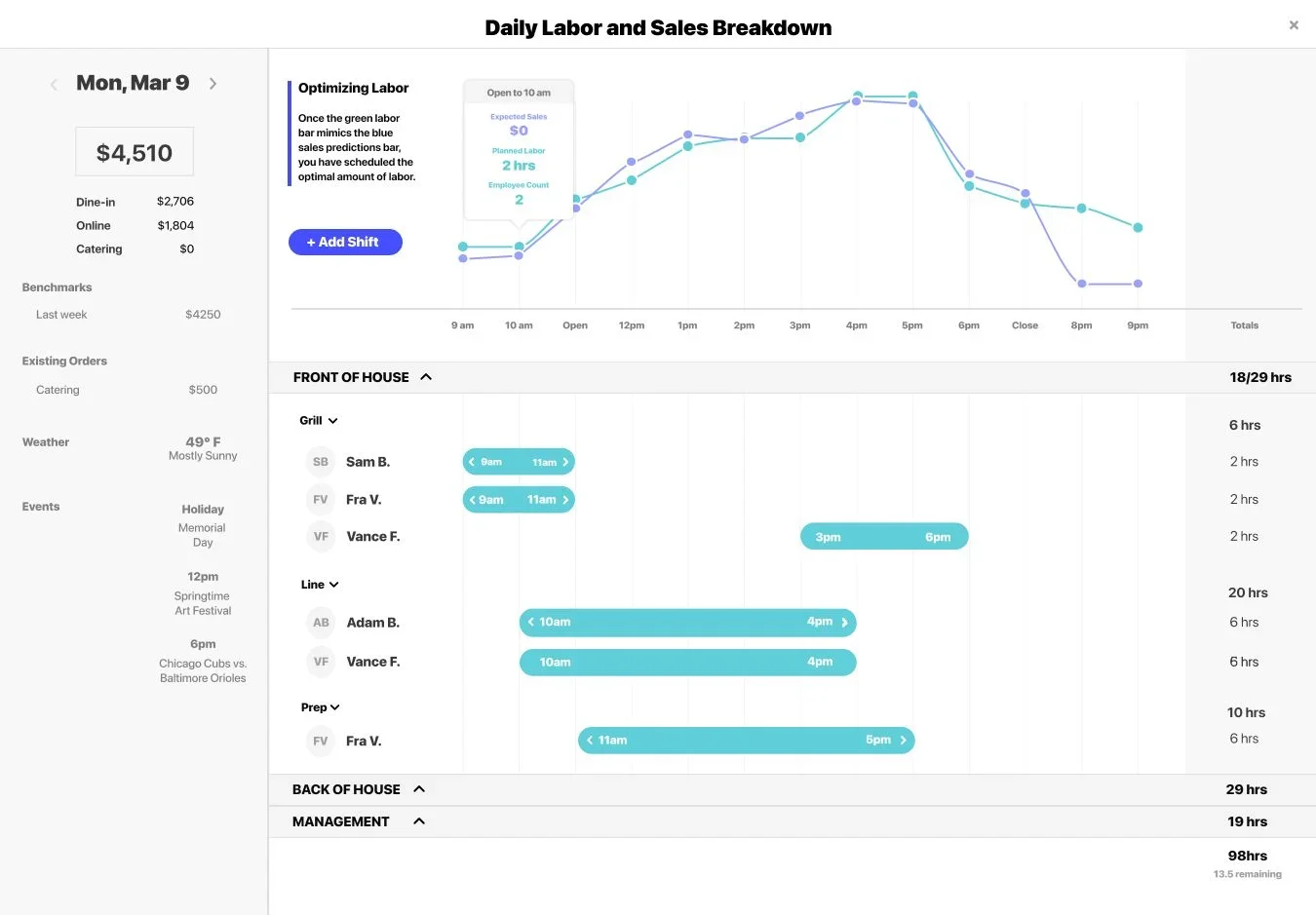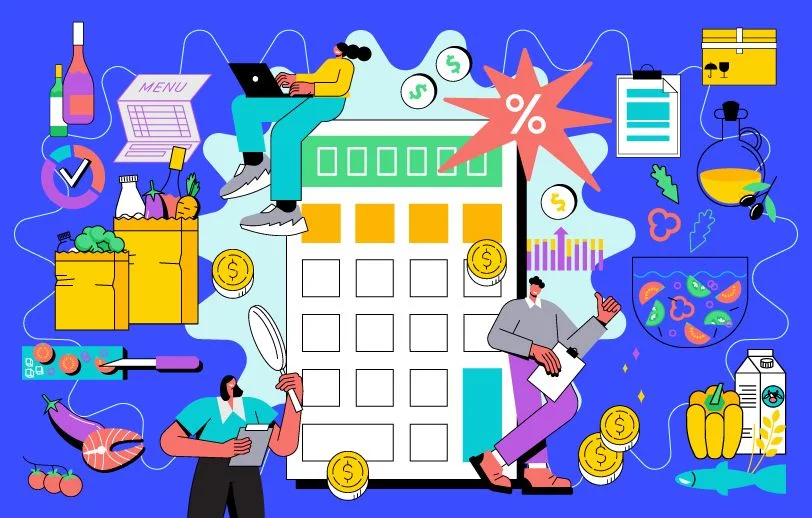In the intricate world of restaurant management, understanding and controlling costs are essential for maintaining profitability and making informed decisions. One key metric that holds significant importance in this regard is the food cost percentage. 92% of restaurants identify higher food costs as a significant challenge.
Food cost percentage not only reflects the relationship between the cost of ingredients and the selling price of dishes but also provides valuable insights into the efficiency of operations and the overall financial health of the restaurant.
According to experts, food costs account for 28-35% of total sales revenue for restaurants in the United States.
This percentage can vary based on the type of restaurant, location, the price of ingredients, and the menu's complexity. For example:
- Fast food or quick service restaurants (QSRs) often have lower food costs, closer to 28% to 30%, because they usually sell high-volume, low-cost items with ingredients that are often bought in bulk.
- Casual dining restaurants might see food costs in the middle of the range, from 30% to 40%, as they balance between quality and cost-efficiency in their offerings.
- Fine dining restaurants can experience higher food costs, sometimes exceeding 35%, due to the use of high-quality, often locally sourced ingredients, and more complex dishes that require skilled labor to prepare.
Calculating the food cost percentage of each dish allows you to determine how much of the menu price goes toward ingredients so that you can adjust the pricing or portion sizes accordingly. In this article, we will look at how to calculate food cost percentage in a restaurant, what the ideal food cost looks like, and how it can benefit your restaurant business.
What is food cost percentage?
Food cost percentage is the percentage of revenue that a restaurant spends on food and beverage products. It's calculated by dividing the cost of goods sold (COGS) by the total revenue generated from food and beverage sales. This figure helps restaurant owners determine how much they're spending on food and beverage products over a given period of time and how much profit they're making.
How to calculate food cost percentage
To calculate food cost percentage, you'll need to follow these steps:
1. Determine your COGS
Cost of Goods Sold (COGS) is the sum of all the direct and indirect costs associated with producing the food or beverage products you sell. Direct costs include the price of ingredients and food supplies (meat, vegetables, spices, etc.) and packaging, while indirect costs include labor, utilities, rent, and other overhead expenses. The formula to calculate COGS is:
COGS = the starting inventory + purchases – ending inventory

Here's an example: If you had $5,000 worth of inventory at the beginning of the month, purchased $10,000 worth of ingredients and supplies, and ended the month with $3,000 worth of inventory, your COGS for the month would be:
COGS = $5,000 + $10,000 - $3,000 = $12,000
2. Calculate your total revenue
This includes all revenue generated from food and beverage sales. This figure is calculated by adding up the total sales from all food and beverage items sold during a given period.
3. Divide the COGS by the total revenue
Use this formula to calculate food cost percentage:
Food Cost Percentage = (Cost of Goods Sold/Revenue)*100

For example, if your COGS is $12,000 and your total revenue from food and beverage sales is $36,000, your food cost percentage would be:
Food Cost Percentage = ($12,000 / $36,000) x 100% = 33.3%
This means that for every dollar in revenue generated from food and beverage sales, $0.33 is spent on the cost of goods sold.
By analyzing your food cost percentage, you can identify which menu items are profitable and which are not. You can also make informed decisions about pricing, purchasing, menu engineering, and reducing waste to improve your restaurant's profitability.
How to calculate food cost percentage per dish?
Your general food cost percentage is helpful for making large-scale changes, but you can drill even further down to food costs by looking at each individual dish. To calculate the food cost percentage for an individual dish, follow these steps:
- Determine the cost of ingredients: This includes the cost of all the ingredients used to prepare the dish, including direct costs (such as the price of the meat, vegetables, spices, etc.) and indirect costs (such as the cost of utilities and labor).
- Calculate the portion cost: This is the total cost of ingredients divided by the number of portions the recipe yields. For example, if a recipe costs $20 to make and yields 4 portions, the portion cost would be $5.
- Determine the selling price of the dish: This is the price you sell the dish for on the menu.
- Calculate the actual food cost percentage per dish: To do this, divide the portion cost by the selling price of the dish and multiply by 100. The formula for calculating the actual food cost percentage per dish is:

For example if the portion cost of a dish is $5 and it sells for $15 on the menu, the actual food cost percentage per dish would be:
Actual Food Cost Percentage = ($5 / $15) x 100% = 33.3%
This means that 33.3% of the selling price is spent on the cost of goods sold for that particular dish.
Calculating the actual food cost percentage per dish allows you to see which menu items are the most profitable and which ones may need to be adjusted. You can use this information to make informed decisions about menu pricing, portion sizes, and ingredient costs to maximize your profits.
By calculating the actual food cost percentage per dish, you can identify which dishes are costing the most to produce. This information can help you to streamline your menu and remove items that are not selling well compared to the revenue they drive. It's a great way to reduce food waste and improve your overall profitability.
Using technology to optimize food costs
When looking for ways to cut costs from your restaurant’s operations, it’s helpful to track the right restaurant metrics over time. Gaining a clearer picture of things like total food sales, inventory costs, labor spending, and more goes a long way toward setting the right benchmarks and goals. Fortunately, we live in an era where data is king and there are tools that can track complex numbers and deliver easy-to-understand reporting of your restaurant business.
Lineup.ai is a sales and labor forecasting tool for restaurants that also helps with scheduling and team communication. Using artificial intelligence, Lineup.ai helps restaurant owners and managers predict sales and labor needs.
If you have an idea of your weekly sales volume, it’s much easier to place food orders and practice effective inventory management so you can lower waste and increase profit margins. which can ultimately impact food costs. It also makes it much easier to lower labor costs when you know you’ll experience a lower volume of orders. The software integrates with your POS system, providing you with a simple way to optimize operations.

Final thoughts
Calculating and optimizing your restaurant’s food costs is crucial for success. Using software and other tools, restaurant owners can accurately track and analyze their food costs, manage inventory, and make informed decisions to increase profitability. Using modern technology can provide valuable insights and real-time analytics that can help owners optimize and set menu prices, improve menu design, automate processes, reduce waste, streamline operations, and ultimately reduce operating expenses.
Restaurant operators should also prioritize staff training on cost management and implement efficient purchasing practices to keep their food costs under control. By taking a proactive approach to managing food costs makes it far more likely that you will have a profitable restaurant. It doesn’t matter if you’re fast food or fine dining–investing in the right tools and adopting best practices for managing food costs can make a significant difference in the bottom line of any restaurant. Restaurant costs will always be high, and you can’t lower food cost, but if you put the right system in place you can absolutely lower your food cost percentage.
FAQs
What is average restaurant food cost per month?
The average restaurant food cost per month typically ranges from 28% to 35% of total monthly revenue. For example, if a restaurant earns $50,000 in a month, food costs may average around $15,000 to $17,500. Actual figures can vary widely depending on restaurant type, location, and menu.
What is the ideal food cost ratio?
Typically, restaurants are advised to maintain a food cost percentage ranging from 25% to 35%. This implies that for every dollar earned in revenue, a restaurant should allocate between 25 to 40 cents towards the purchase of the ingredients that constitute the dish.
What is a good profit margin for restaurant food?
A favorable profit margin for restaurant food is generally in the range of 5% to 10%. This means that after accounting for all costs, including ingredients, labor, overhead, and other expenses, the restaurant should aim to retain 5% to 10% of its revenue as profit. However, profit margins can vary based on factors like the restaurant's concept, location, pricing strategy, and operational efficiency. It's essential to balance profitability with providing value to customers and maintaining competitiveness in the market.
Is 30% food cost percentage good?
To ensure the profitability of a restaurant, many proprietors and managers aim to maintain food costs at around 28% to 35% of their revenue. However, it's important to note that there isn't a universally perfect food cost percentage. This figure fluctuates based on factors such as the restaurant's cuisine, overhead costs, and operational expenditures.
What is actual food cost?
Actual food cost is the exact expense of ingredients used within a specific timeframe, encompasses all food consumed by the restaurant. This calculation considers factors like incomplete portions, unintended food waste, billing errors, and potential employee misappropriation, directly influencing the establishment's financial state and potential profits.
How to calculate food cost for a recipe?
Calculating the food cost for a recipe is an essential task for chefs and restaurant owners. To calculate food cost for a recipe, follow these steps:
- List ingredients.
- Determine ingredient quantities.
- Find ingredient prices.
- Calculate ingredient costs.
- Sum up ingredient costs.
- Determine portion size.
- Calculate labor and overhead costs.
- Add desired profit margin.
- Set menu price accordingly.

The team at Lineup.ai is composed of seasoned professionals who hold deep insights into the unique challenges and pain points of the restaurant industry, and are equally skilled in artificial intelligence, machine learning, and data analytics. This fusion of expertise enables Lineup.ai to create cutting-edge AI solutions specifically tailored for the restaurant sector. The technical and analytical prowess of the team, combined with a deep understanding of the unique challenges faced by restaurants, forms the cornerstone of the company's innovation. The team at Lineup.ai also excels in communicating the benefits and applications of AI and machine learning to businesses, ensuring clients fully leverage the capabilities of these solutions.
More about the author